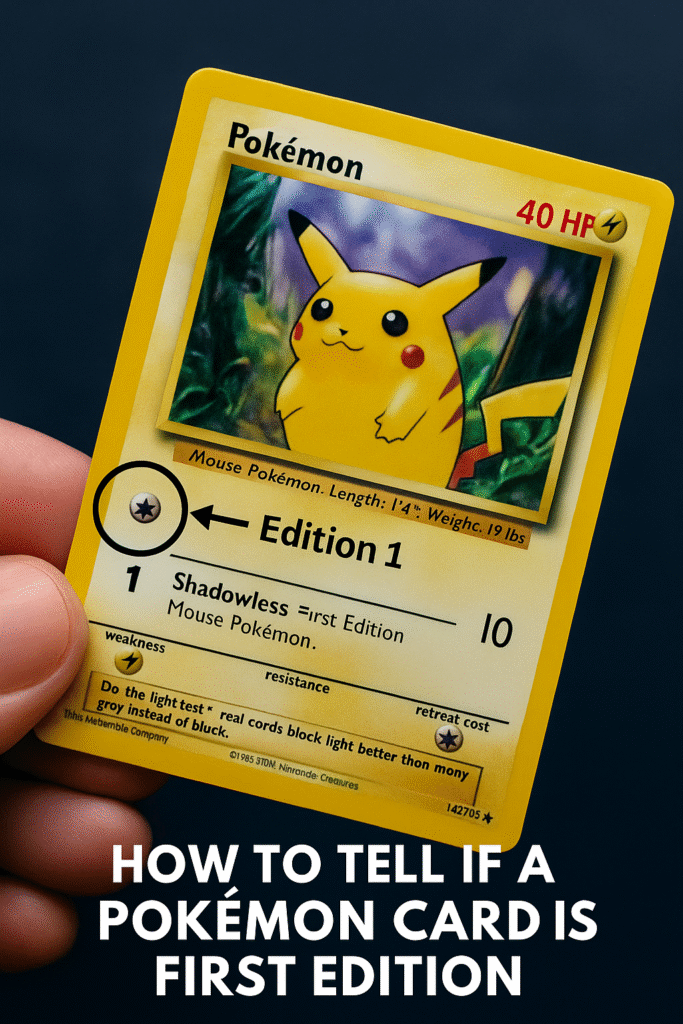
7 Proven Ways to Tell if a Pokémon Card Is First Edition
If you’ve found an old binder or bought a mystery lot, you’re probably wondering how to tell if a Pokémon card is first edition. First edition cards from the late 1990s–early 2000s (English Wizards of the Coast era) can be far more valuable than their unlimited counterparts—if they’re authentic. Use these seven checks in order for a quick, reliable ID.
1) Look for the “Edition 1” Stamp (Primary Indicator)
The most direct sign how to tell if a pokemon card is first edition print is the small black “Edition 1” stamp. On English WotC-era cards, it typically appears to the left of the artwork box (or near the lower-left of the card face, depending on the set). If you’re learning how to tell if a Pokémon card is first edition, this stamp is step one. Beware: fake stamps can be off-center, blurry, gray instead of black, or the wrong size.
2) Confirm the Set and Card Number
Check the card’s set symbol and number (usually bottom-right). Make sure the card actually exists in first edition within that set. Early English sets (Base, Jungle, Fossil, Team Rocket, Gym Heroes/Challenge, Neo-era) have first edition prints. Later English prints discontinued the 1st Edition stamp. If the combo of set + number doesn’t match known first edition checklists, it isn’t first edition.
3) Shadowless vs. Shadowed (Base Set Specific)
For Base Set: first edition cards are also “shadowless” (no drop shadow along the right side of the artwork box). However, not every shadowless card is first edition—there are shadowless unlimited prints without the 1st Edition stamp. If you’re focusing on how to tell if a Pokémon card is first edition in Base Set, you need both the 1st Edition stamp and the shadowless layout.
4) Check Copyright Line, Fonts, and Print Quality
Look closely at the fine print along the bottom: the copyright line, font weight, kerning (spacing), and ink density. Authentic first edition stamps are crisp, deep black, and consistently placed. Inconsistent fonts, washed-out text, or misaligned symbols are common red flags when verifying how to tell if a Pokémon card is first edition.
5) Compare Holo Pattern and Card Stock (If Applicable)
On holos, examine the holographic layer for even patterning and no “pixel grid” look. Genuine WotC cards have specific cardstock and finish; forgeries often feel too glossy, too thin, or too stiff. If you’re serious about how to tell if a Pokémon card is first edition, compare your card against a known authentic copy under good light.
6) Region and Language Matter
Japanese cards used “1st Edition” indicators differently and for longer than English prints. Placement, symbols, and even the presence of a first edition marking can vary by region and era. Always verify the specific rules for that language and set when learning how to tell if a Pokémon card is first edition.
7) Packaging Clues and Distribution Notes
Booster boxes and packs from the period can provide supporting evidence (e.g., first edition–labeled boxes/packs), but packaging alone doesn’t prove an individual card’s status. Treat packaging as context, then confirm with the card-level checks above.
Common Mistakes to Avoid
- “Shadowless = First Edition”: Not always. Shadowless unlimited exists; you still need the 1st Edition stamp.
- “Modern sets have 1st Edition”: English first edition stamping ended after the early 2000s WotC era.
- “Rarity symbol proves it”: Circle, diamond, and star indicate rarity, not first edition status.
Authenticity Tips
- Do the light test: real cards block light better than many fakes.
- Check blue core on edges under bright light (common in authentic TCG stock).
- Use a loupe to inspect printing dots—authentic halftone patterns differ from home-printer fakes.
FAQ
Do all valuable cards have to be first edition?
No. Some unlimited prints and later-era cards are valuable for other reasons (rarity, condition, tournament relevance). First edition is just one value driver.
Is the “Edition 1” stamp ever missing on real first edition cards?
For English WotC-era prints, first edition should carry the stamp. If it’s missing, it’s typically not first edition (or it’s a misprint—rare, but verify carefully).
Does grading confirm first edition automatically?
Reputable graders (PSA, BGS, CGC) label first edition status on the slab if present. Grading also authenticates the card, which helps buyers and sellers.
What’s the fastest way to tell at a glance?
Look for the crisp black “Edition 1” stamp in the expected position. Then confirm set/number and, for Base Set, the shadowless layout. Those three checks catch most cases.
Helpful Resources
- PSA CardFacts (set checklists & population data)
- Bulbapedia (set symbols & print run notes)
- Pokémon Support (official TCG resources)
Explore More on AnswerNimbus
Love collecting? Browse our Collectibles guides for identification tips, care, and value basics.
AnswerNimbus is an online knowledge hub providing step-by-step guides, how-to fixes, and clear explanations across technology, home, collectibles, and everyday curiosities. Our mission is to make useful information easy to find, understand, and apply.
